 Tonight's full moon looks larger than normal because the moon is at its closest to earth. We saw it from Evelyn and Tom's house nearly an hour after official moonrise.
Tonight's full moon looks larger than normal because the moon is at its closest to earth. We saw it from Evelyn and Tom's house nearly an hour after official moonrise.
Saturday, March 19, 2011
Super Moon
 Tonight's full moon looks larger than normal because the moon is at its closest to earth. We saw it from Evelyn and Tom's house nearly an hour after official moonrise.
Tonight's full moon looks larger than normal because the moon is at its closest to earth. We saw it from Evelyn and Tom's house nearly an hour after official moonrise.
Wednesday, March 16, 2011
Happy Saint Patrick's Day
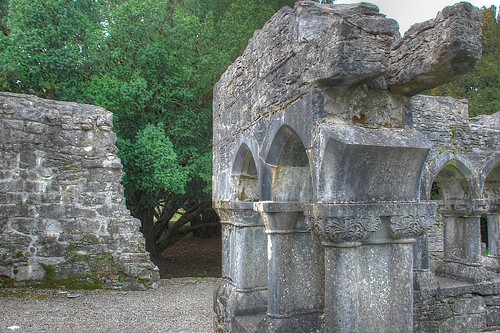
Our trip to Ireland was fabulous. We found that both art and nature support the popular expectation we've had for Irish imagery.
 This will be my last post on Ireland, as we've now been back for over a week.
This will be my last post on Ireland, as we've now been back for over a week.Thus Len's HDR photo of an old cloister at Coing Abbey (above) illustrates the deep green foliage one might associate with Irish landscapes, along with beautiful medieval arches. And the modern water meter to the right also uses a Celtic knot design.
We find the Irish to be welcoming and extraordinarily friendly. Arny and Tracy's friends, people in shops and on the street, museum attendants, Bed and Breakfast and restaurant personnel, airport staff (yes, even security) -- all made us feel welcome. We were a bit startled to find all the usual Irish stuff like magnets and shirts that say "Kiss me, I'm Irish," toy leprechauns, and other cliched things that I thought were just for St.Patrick's day in the US!
So have a wonderful St.Patrick's Day. I think that the bars in Ireland will also be totally busy tomorrow, just like the bars over here. And I hope all the days are sunny -- though the photo below of the Claddagh in Galway illustrates that we also saw a bit of Irish mist from time to time.

Saturday, March 12, 2011
Irish Nostalgia
 Last night we went to see Martin McDonagh’s play, The Cripple of Inishmaan, performed by the Irish Druid and Atlantic Theater Company. The sponsor was University Musical Society, which presents music and drama at various venues here in Ann Arbor -- it's a coincidence that they put on an Irish play that's so timely for me. When an ad came in the mail, I couldn't resist; we went with our friends Bob and Elaine, who are theater lovers.
Last night we went to see Martin McDonagh’s play, The Cripple of Inishmaan, performed by the Irish Druid and Atlantic Theater Company. The sponsor was University Musical Society, which presents music and drama at various venues here in Ann Arbor -- it's a coincidence that they put on an Irish play that's so timely for me. When an ad came in the mail, I couldn't resist; we went with our friends Bob and Elaine, who are theater lovers.The action of the play takes place on Inishmaan, one of the Aran Islands just off Galway -- last week, on clear days, we could see this group of islands on the horizon from the Cliffs of Moher where we took a walk (photo of Lenny on the cliffs right/above; islands vaguely behind him).
The characters in the play are colorful and a bit of a cliche -- two oldish women, a gossipy old man and his very very old mother (who drinks poteen), a none-too-virtuous girl, her brother, and the title role, a crippled boy. The performance was what I would call theatrical: very stylized acting, sort of proclaimed. I enjoyed it, but it was unfamiliar: totally different from watching a movie. Of course the characters all speak in a strong Irish accent, which underscores the folksy, retro quality of the plot and the dialogue. Like many tales of common people, comedy and tragedy combine in the course of the play; what Sholem Aleichem called laughter through tears.
The experience of this play seemed very consistent with an article I recently read in the Guardian titled IRISH EXCEPTIONALISM. It asked why the recent dramatic economic boom and bust seems to have had little impact on Irish fiction -- after looking at recent Irish plays, songs, art exhibits, etc, the Guardian author seems to find only that YouTube is "dripping with home-made 'bail-out songs.'"
And, says the author, recent events resemble a fictional production, maybe a good play:
"The cast of characters is superlative, featuring buccaneering bankers, outsized politicians and all-conquering property developers .... Even the locations are enticing, from rural beauty spots blighted by "ghost estates" to high-end networking jamborees masquerading as racing events."However, the Irish continue to write about their past, rather than their present and future, says this thoughtful article. One conclusion: "many of us hold tight to outdated notions of Ireland as a romantic sort of place that only the artist can really understand." Though I liked McDonagh’s Cripple of Inishmaan last night, I think this statement sums it up."You'd expect this sorry tale to have generated a wave of films, plays and novels. After all, the Irish have never shied away from telling stories about themselves. Visual artists must have hit upon a new mode of expression. Musicians, surely, would have found a way to express the story through song, as they have done with so many of Ireland's historical traumas. Hell, this story could make an opera."
Note: I also liked the review of the play in the local online newspaper.
Friday, March 11, 2011
Irish Sheep
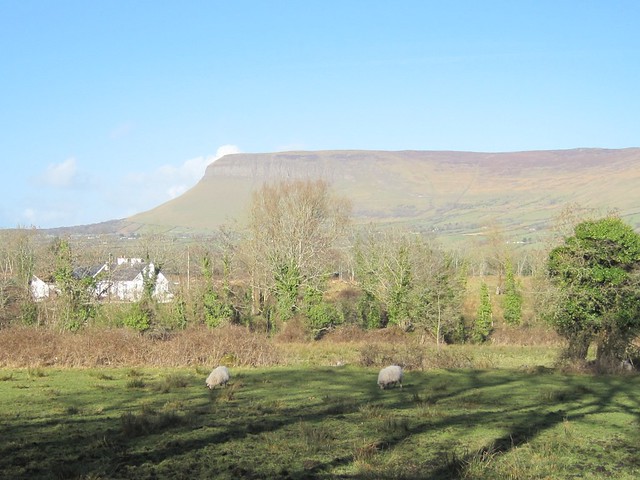
Irish woolens are still being made -- we saw beautiful scarves and thows for sale, but had lots of sales resistance. We also saw the sheep, which still had their large fleece winter coats on. The sheep in the field above are grazing under Ben Bulben, the mountain made famous in several of Yeats's poems.
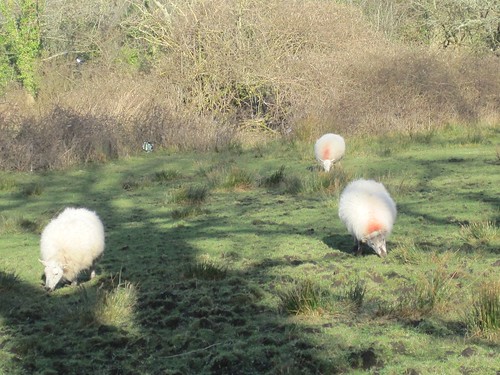
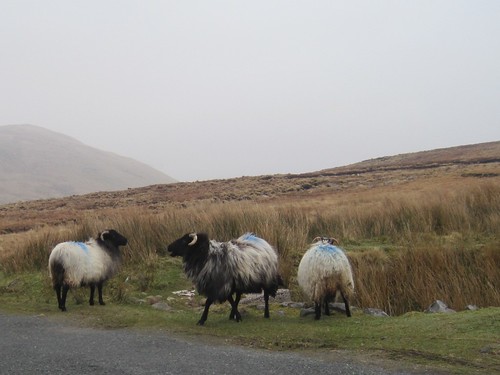
Thursday, March 10, 2011
Where do Irish Fairies Live?
The landscape in Ireland is full of ancient stones. Old towers and seaside fortifications from the Middle Ages. Early Christian churches, holy wells, and abbeys with a few standing arches from once-secluded cloisters. Stone walls from all eras dividing the land into sheep pens. Ruined castles from many different centuries. The giant Finn McCool's causeway. And neolithic tombs, forts, and other constructions.
My perspective in seeing all these bare stones on my three trips to Ireland has always been historical: I try to learn about the eras when many races and tribes came to Ireland and built new lives and new stone structures. I envisioned how these peoples cut down the ancient forests and turned them into bogs and stony fields. I read about centuries of fighting, famine, colonization, and other events affected the landscape.
But how did the Irish farmers two centuries ago view all this evidence showing centuries of human occupation? They had little historic information, and less understanding of how ancient the neolithic tombs and forts were created. The mysteries of their surroundings created a sense of enchantment. Irish folk tales invented Finn McCool to create the giant's causeway, and imagined races of fairies, wee people, leprechauns (who are originally shoe makers), banshees, and many others to populate these very scary ruins. In their stories, doors would open amidst the stones, old tombs would light up and songs would sound into nighttime darkness, and the old castles would come to life with ethereal people who couldn't be seen in daylight.
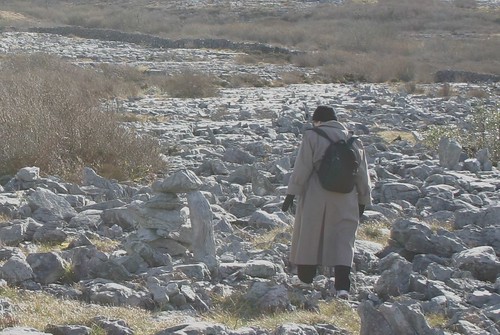
Neolithic stones, photo from our 2005 trip.
In reading William Butler Yeats's Irish Fairy and Folk Tales, I'm getting a much more vivid picture of how the fairies live. In one story, a man named Lusmore was walking slowly home one night, when "he came to the old moat of Knockgrafton, which stood on the right-hand side of his road." A moat is a neolithic tomb, such as I saw on my trip.
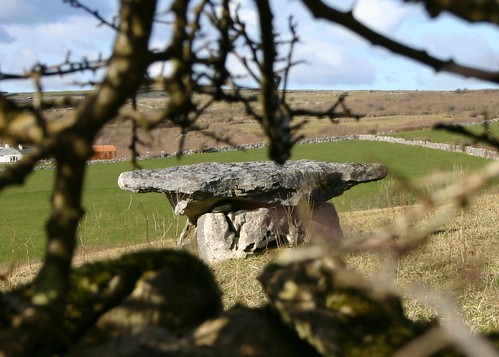
Another neolithic tomb in The Burren, from our 2005 trip
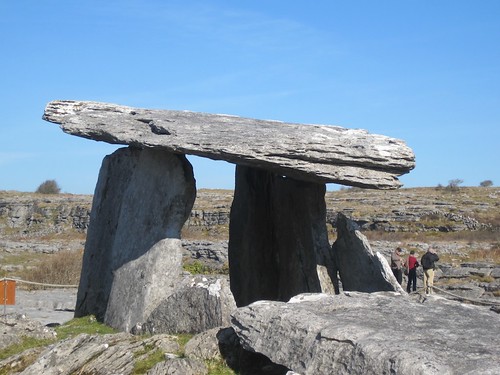
Poulnabroe, a well-preserved neolithic portal tomb

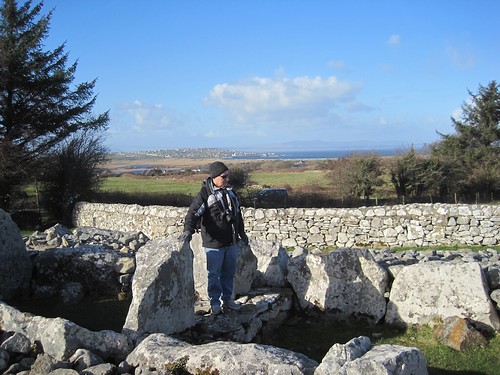
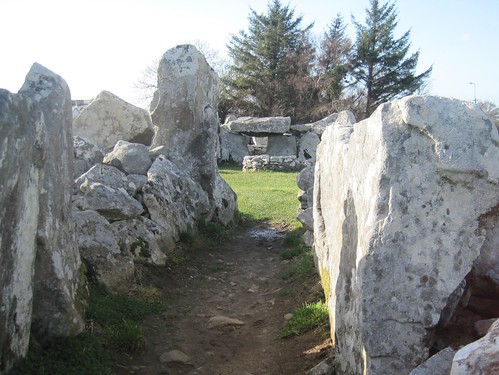
One more portal tomb, north of Sligo, 2011
Castles such as the ones we saw were also homes for fairies; from the tale of a young man:
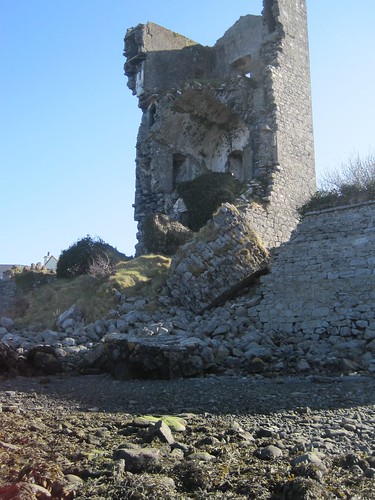
If fairies or pookas come here now, they disturb the residents of the just-visible adjacent housing development!
My perspective in seeing all these bare stones on my three trips to Ireland has always been historical: I try to learn about the eras when many races and tribes came to Ireland and built new lives and new stone structures. I envisioned how these peoples cut down the ancient forests and turned them into bogs and stony fields. I read about centuries of fighting, famine, colonization, and other events affected the landscape.
But how did the Irish farmers two centuries ago view all this evidence showing centuries of human occupation? They had little historic information, and less understanding of how ancient the neolithic tombs and forts were created. The mysteries of their surroundings created a sense of enchantment. Irish folk tales invented Finn McCool to create the giant's causeway, and imagined races of fairies, wee people, leprechauns (who are originally shoe makers), banshees, and many others to populate these very scary ruins. In their stories, doors would open amidst the stones, old tombs would light up and songs would sound into nighttime darkness, and the old castles would come to life with ethereal people who couldn't be seen in daylight.

Neolithic stones, photo from our 2005 trip.
In reading William Butler Yeats's Irish Fairy and Folk Tales, I'm getting a much more vivid picture of how the fairies live. In one story, a man named Lusmore was walking slowly home one night, when "he came to the old moat of Knockgrafton, which stood on the right-hand side of his road." A moat is a neolithic tomb, such as I saw on my trip.
"Tired and weary was he, and noways comfortable in his own mind at thinking how much farther he had to travel, and that he should be walking all the night; so he sat down under the moat to rest himself, ... Presently there rose a wild strain of unearthly melody upon the ear of little Lusmore; he listened, and he thought that he had never heard such ravishing music before. It was like the sound of many voices, each mingling and blending with the other so strangely that they seemed to be one, though all singing different strains, and the words of the song were these--"Da Luan, Da Mort, Da Luan, Da Mort, Da Luan, Da Mort;"when there would be a moment's pause, and then the round of melody went on again. ... The fairies within Knockgrafton, for the song was a fairy melody ... " -- The Legend of Knockgrafton

Another neolithic tomb in The Burren, from our 2005 trip

Poulnabroe, a well-preserved neolithic portal tomb



One more portal tomb, north of Sligo, 2011
Castles such as the ones we saw were also homes for fairies; from the tale of a young man:
"An old ruined castle, about a quarter of a mile from his cabin, was said to be the abode of the 'wee folk.' Every Halloween were the ancient windows lighted up, and passers-by saw little figures flitting to and fro inside the building, while they heard the music of pipes and flutes. It was well known that fairy revels took place; but nobody had the courage to intrude on them." -- Jamie Freel and the Young Lady

If fairies or pookas come here now, they disturb the residents of the just-visible adjacent housing development!
Tuesday, March 08, 2011
Boats in Port
Galway Bay is full of fishing and shipping boats. Tiny towns beside the sea offer fresh oysters, mussels, crab, and local salmon from boats and other fishing methods; I wrote about what we ate in these posts: Monk's Pub, Ballyvaughn Ireland and Coole Oysters. The city of Galway has berths for ocean-going cargo ships, though it's not a massive container port; the scale of ships is still a picturesque and modest.
At low tide in the small harbor at Kinvara the little fishing and pleasure boats we saw were resting on the mud:
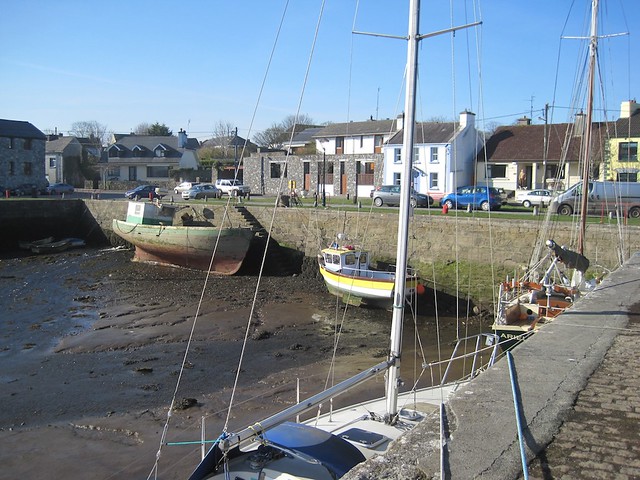
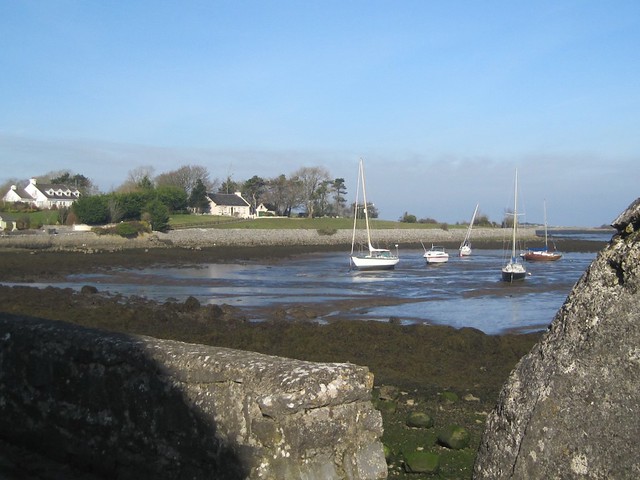
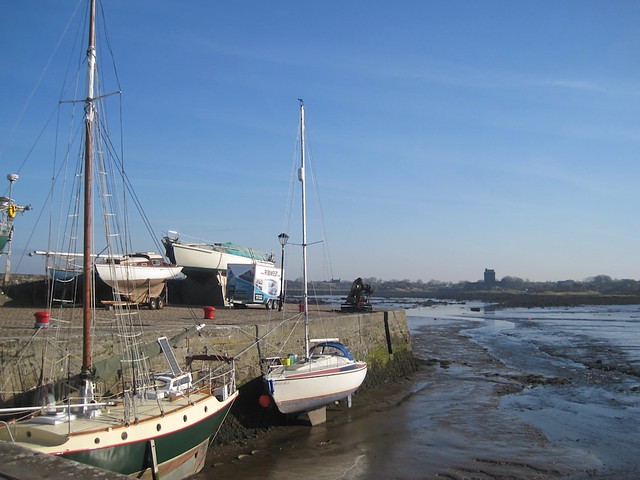
We also stayed overnight at Killybegs, the largest Irish fishing port for the Atlantic. At night from our room we could see the big trawlers in the harbor:
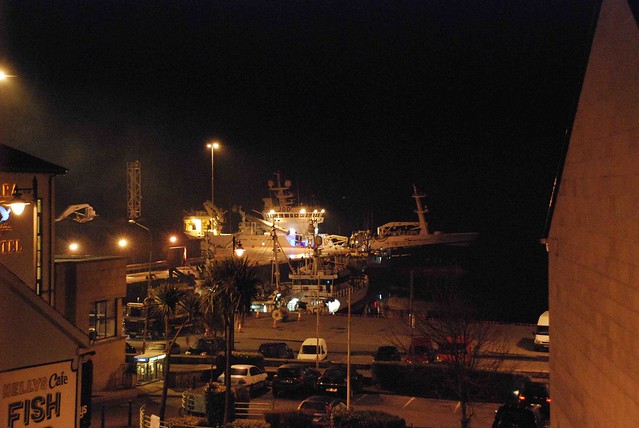
In Dublin our B&B on Clontarf Road had a view of the ferry boats that cross from Ireland to Wales and elsewhere across the Irish Sea. We walked out towards the islands that face Dublin.
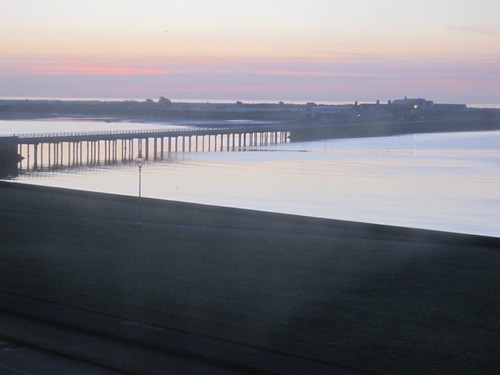
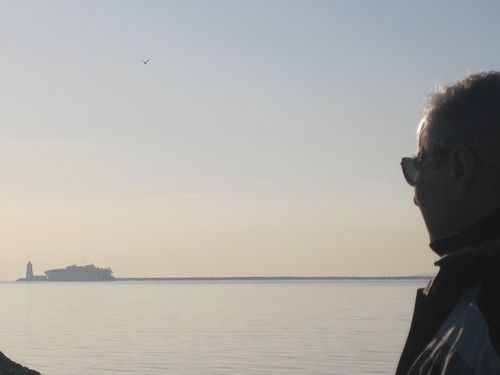
At low tide in the small harbor at Kinvara the little fishing and pleasure boats we saw were resting on the mud:



We also stayed overnight at Killybegs, the largest Irish fishing port for the Atlantic. At night from our room we could see the big trawlers in the harbor:

In Dublin our B&B on Clontarf Road had a view of the ferry boats that cross from Ireland to Wales and elsewhere across the Irish Sea. We walked out towards the islands that face Dublin.


Monday, March 07, 2011
The Giant's Causeway

Last Saturday afternoon Kīlauea Volcano on the Big Island of Hawaii began a new and spectacular eruption from a fissure that suddenly opened on the mountainside, sending a flow of lava into a seemingly bottomless crack in the earth. The goddess Pele, who controls Hawaii's volcanic activity, must have been really mad! (Above photo comes from the USGS Hawaiian Volcano Observatory. For scale: the spewing fires are around 30 meters high -- click on the picture to see a larger version in which you can see the burning trees beside the lava and a tiny geologist to the right.)
Around 62 million years ago, an even more enormous volcano than Kīlauea erupted in northern Ireland. The eruption created basalt pillars of great size as the lava slowly cooled and contracted. Over time, additional eruptions, water percolation, erosion, waves, ice floes, and other geological forces created the Giant's Causeway, an amazing array of geometrically regular pillars and stones. These rock formations are so evenly shaped that it's hard to believe they are natural.
Like the Hawaiians, who imagined Pele's wrath and power as the source of the inexplicable appearance of lava and eruptions, the ancient Irish believed in anthropomorphic forces as the explanation for the mysterious rock formations: the giant Finn McCool was their mythic builder. Unlike Pele, Finn wasn't angry: the story says he just didn't want to get his feet wet when he walked to Scotland across the channel, so he paved the ground with regular stones.
Our visit to the Giant's Causeway was certainly the most amazing part of our recent trip to Ireland. We loved walking on the stone pavement that Finn put down, climbing up between the pillars, and enjoying an unusually warm and sunny February day. We both enjoyed taking photos -- here are some favorites:

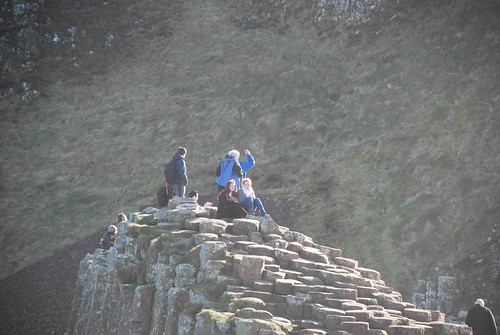
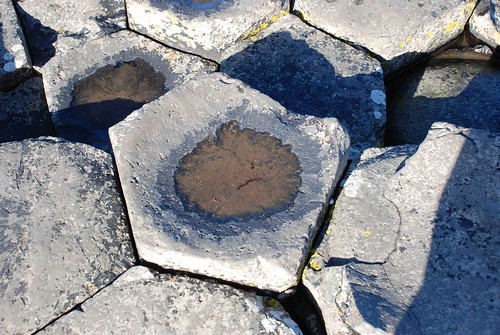
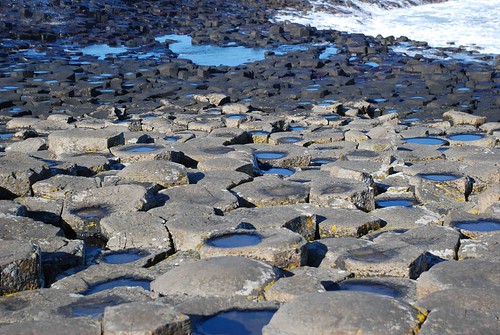
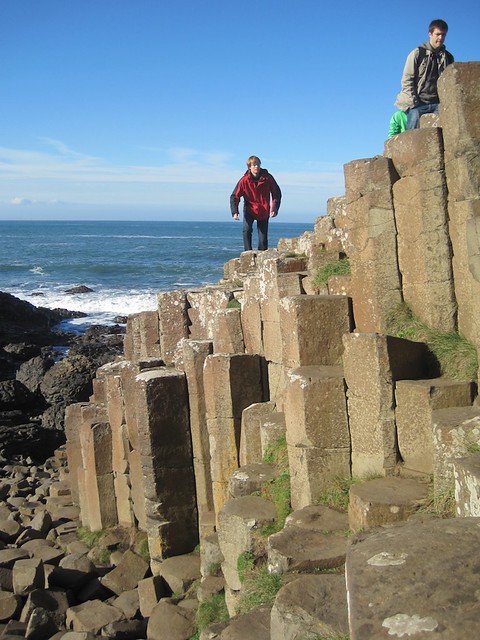
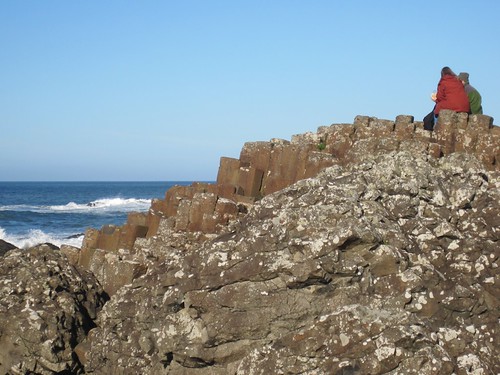
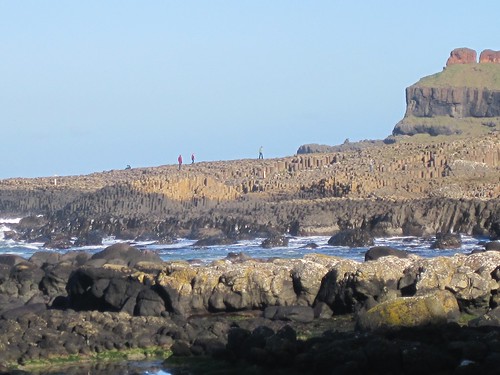
Sunday, March 06, 2011
Irish Politics
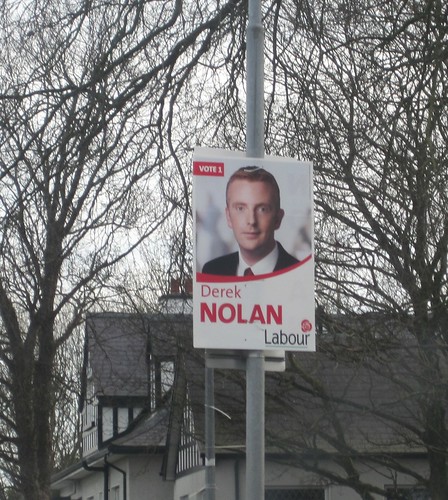
We arrived in Ireland on election day, and as we traveled, we constantly saw candidate posters, mostly on the lampposts. This is Derek Nolan, a young Labor candidate from the Galway district where Arny and Tracy are currently living. His posters were the first to go up, say Arny and Tracy -- though the campaign in Ireland is only a few weeks -- in great contrast to the US!
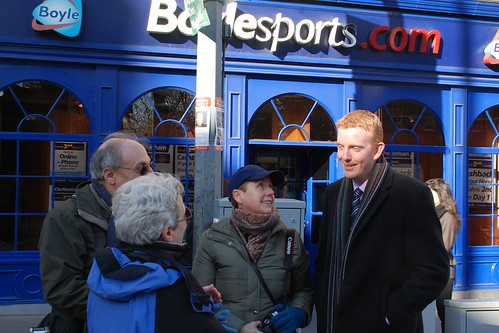
Just as we arrived in Dublin, we met Derek Nolan on the street, as shown above. He seemed happy to be recognized: the vote count had just been completed, so he was on the way to his first meetings prior to the induction of the newly elected Irish Parliament. The vote count is done by hand and is incredibly complex. Each voter numbers his preferred candidates beginning at 1 (as urged on all the signs) and going up to whatever number the voter likes -- sometimes 20 people might run for 5 slots. Each of the 4 parties proposes a slate of candidates, and independents also play a big role. So multiple recounts are needed to determine the winners.
This election was a really big upset for the Fianna Fail party that has been in power for many years. In Killybegs where we spent a night, our B&B hosts and the waiter at the restaurant where we ate were really excited because a young independent from their town had defeated the second in command of the government. Here's the poster for this big loser, Mary Coughlan, who's now out of power along with her entire party:
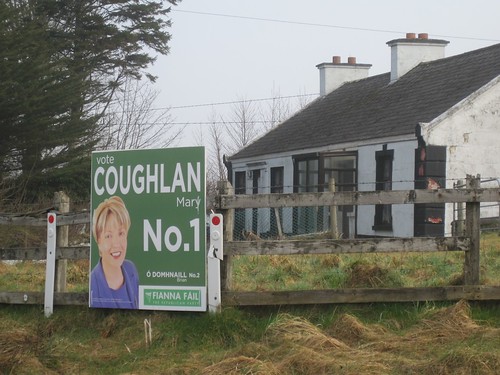
Reprecussions from the boom and bust of the last few years were the major issues in the election, with huge animosity towards Finanna Fail. The Fine Gael party, Labour, Sinn Fein (with roots in the old Independence movement), and independents all did well, but none had a majority, so ongoing negotiations were taking place all week -- with a little interference from Angela Merkel, German Chancellor. Fianna Fail was corrupt and had sweetheart deals with the banks, which have big debts to German banks (hence Merkel's interest). Irish people are angry because they have been left in a very bad economic situation, while the bankers are still collecting big salaries after lots of bad doings.
As we traveled we saw building projects abandoned, and occasional other evidence of how the enormous period of prosperity nicknamed "The Celtic Tiger" that was present during our 2005 trip has gone bust. The big influx of people from Poland and other Common Market countries have been leaving, as well as lots of unemployed Irish people, especially recent graduates. Tourism is down. The high-tech industry is in vast decline. And everyone is demoralized because they had hoped the change in Ireland's fortunes was permanent.
Friday, March 04, 2011
Misty Ireland
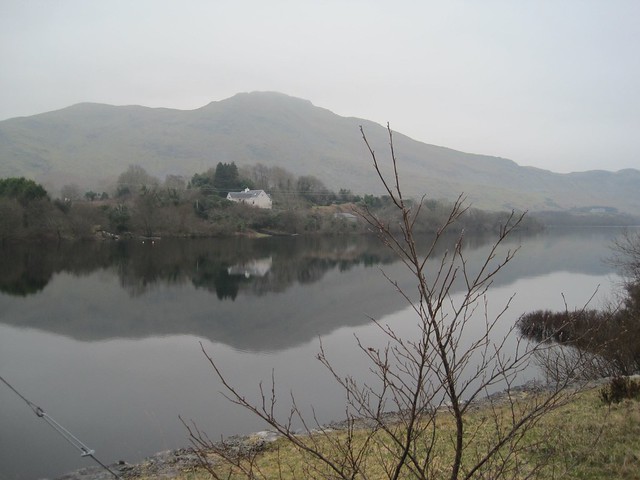
We had several beautiful sunny days, but today it was more typical Irish weather. We drove up from Arny's Galway house towards the northwest, where we walked near Loch Nafooey and Loch Corrib. We would not have been surprised to see some faerie persons, who would have whisked us into the woods for 25 years, and we would have returned no older than we are now. Is that bad or good?

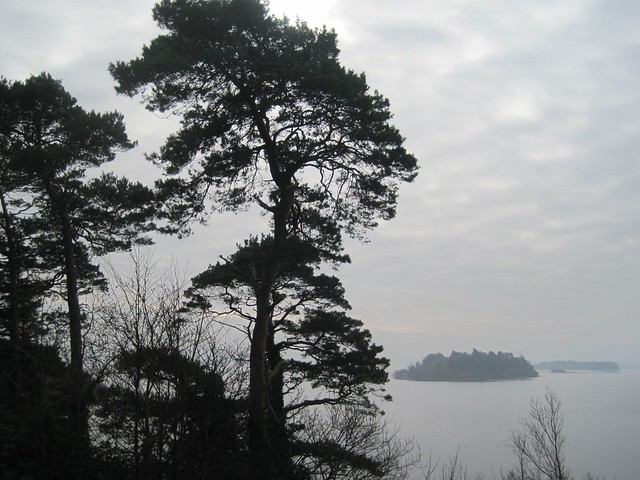
Loch Nafooey:

Thursday, March 03, 2011
Irish Castles
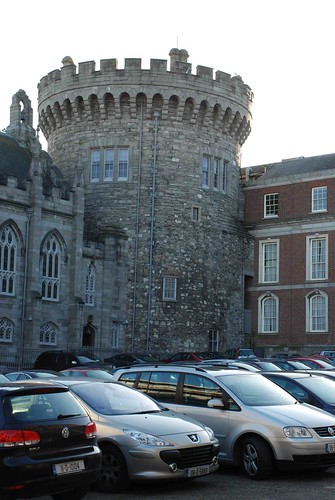
In Dublin, we toured Dublin Castle. It was the seat of English rule of Ireland until 1922, when it was turned over to the new Republic. The tower is medieval, the rest much newer.
Today we roamed through The Burren, a region of very rocky hills and cliffs. Ancient stone tombs from pre-Celtic people are the best known, but many sorts of castles were also a highlight of the visit. The earliest were built in the 7th century. Some are ruins through which you can see the sky. Others look nearly new, and are private residences or hotels, probably incorporating one much older tower. Some were obviously fortified, and face the sea; others appear to have been stately residences for wealthy land owners. Were they ruined by time or by rebellions? We don't really know.
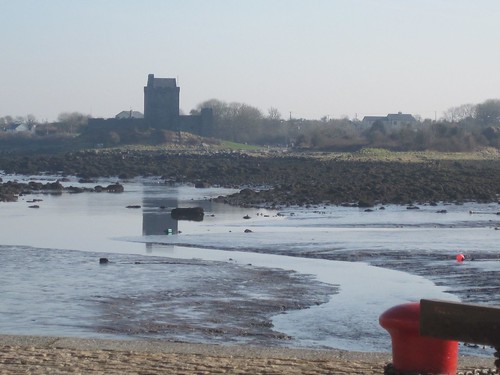



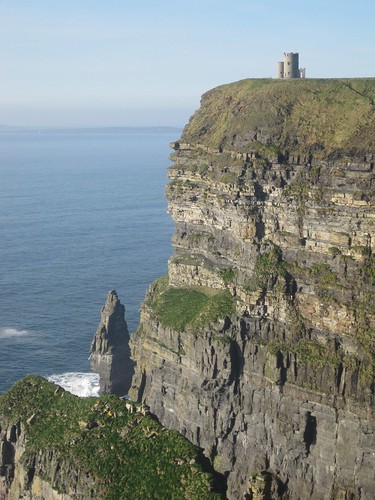

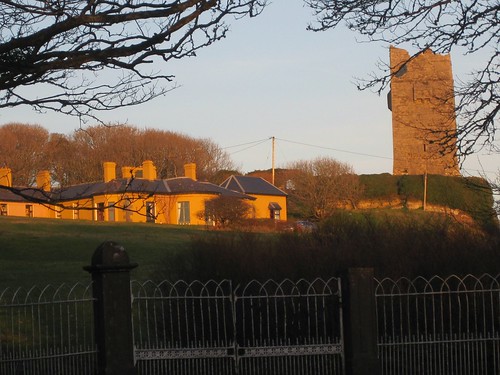
As we left The Burren, the sun was setting over the water.
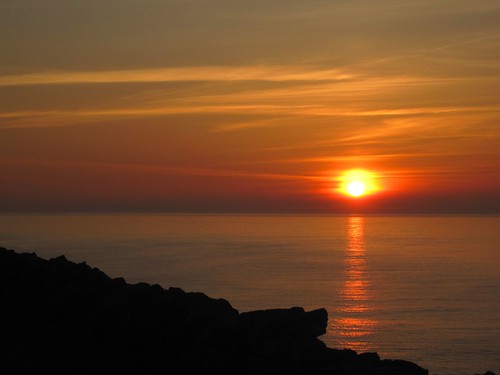
Irish Walls
Everywhere in Ireland I've seen beautiful walls. Some are old, some new, but all grow moss, ivy, and other green stuff thanks to the constant damp and rain.
First, the wall of the churchyard where Yeats is buried:

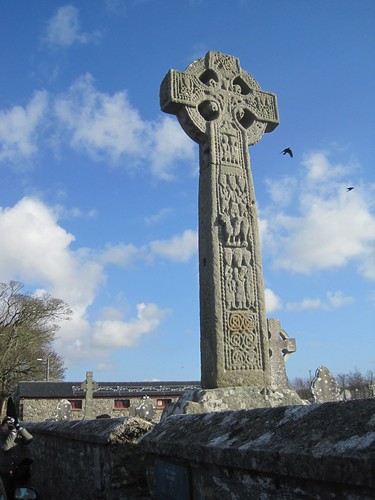

And the walls of Lady Gregory's estate, Coole, where Yeats lived for many summers.

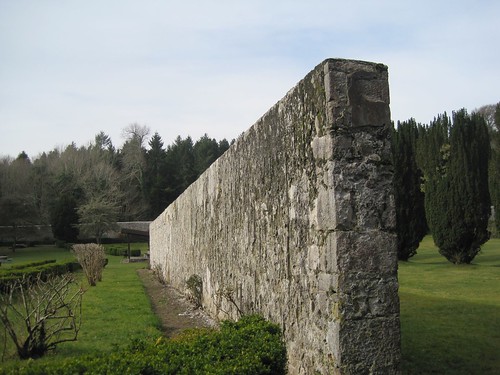
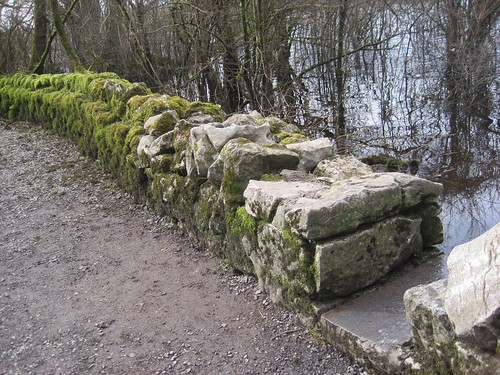
The walls of the 12th century Assaroe Abbey, incorporating old water wheels:

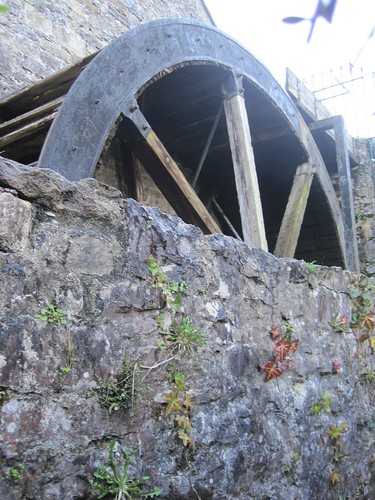
A prehistoric passage tomb from the ancient Celtic inhabitants of Ireland:
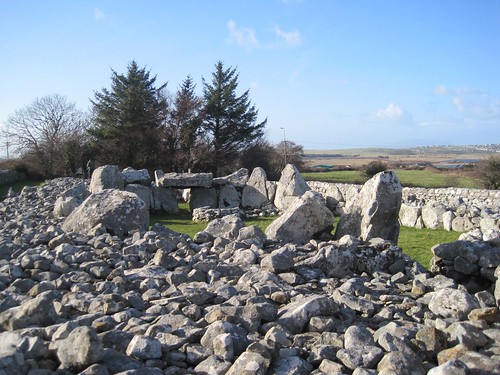
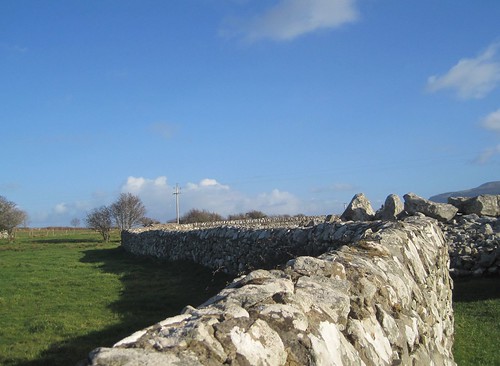
The Galway Medieval city wall
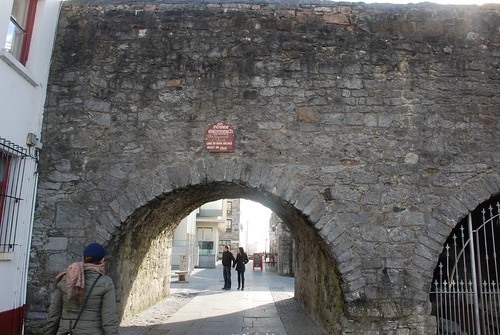
An old wall and bridge:
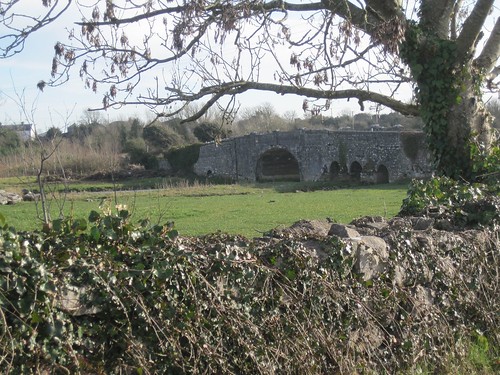
A wall with rough stones at the top, a type I have frequently seen in Galway:

A wall by a sea inlet:
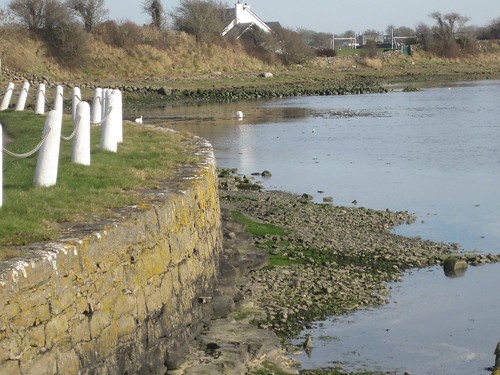
First, the wall of the churchyard where Yeats is buried:
"Under bare Ben Bulben's head
In Drumcliff churchyard Yeats is laid.
An ancestor was rector there
Long years ago, a church stands near,
By the road an ancient cross."


"No marble, no conventional phrase;
On limestone quarried near the spot
By his command these words are cut:
Cast a cold eye
On life, on death.
Horseman, pass by!"

And the walls of Lady Gregory's estate, Coole, where Yeats lived for many summers.



The walls of the 12th century Assaroe Abbey, incorporating old water wheels:


A prehistoric passage tomb from the ancient Celtic inhabitants of Ireland:


The Galway Medieval city wall

An old wall and bridge:

A wall with rough stones at the top, a type I have frequently seen in Galway:

A wall by a sea inlet:

Subscribe to:
Comments (Atom)